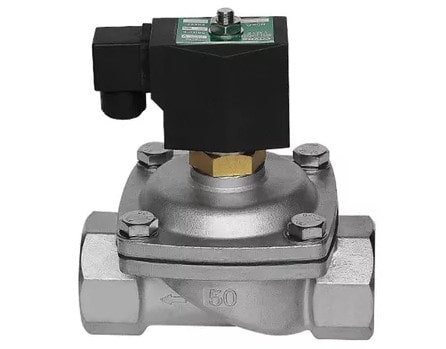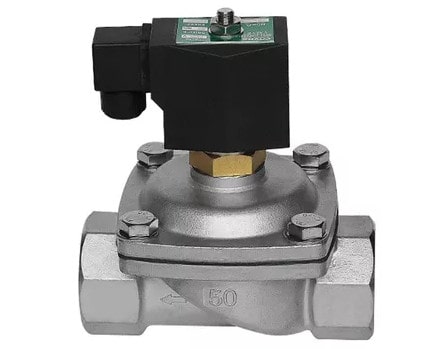The solenoid valve coil is rated for a voltage of DC12V, DC24V, AC24V (50/60Hz), AC110V (50/60Hz), AC220V (50/60Hz) or AC380V (50/60Hz).
In electrical projects, AC220V is often used because it does not require a switching power supply and is low cost, with a simple circuit and easy maintenance. Alternatively, DC24V is commonly used due to its widely used safety voltage and ease of repair and replacement of the switching power supply and solenoid valve coil.

1. The method of testing the quality of solenoid valve
To test the solenoid valve, first connect it to controlled medium (such as a pressurized liquid or gas such as air) with a pressure value in the middle range of the solenoid valve's pressure range. Then activate the solenoid coil.
If the controlled medium can change from on to off or from off to on, the solenoid valve is working properly. If this is not the case, there may be a problem with the valve.
2. Common Solenoid Valve Failures
2.1 Coil short circuit or interruption
Detection method:
To diagnose the condition of a solenoid valve, use a multimeter to measure its on/off state. If the resistance tends to zero or infinity, this indicates that the coil is short-circuited or open-circuited.
Even if the measured resistance is normal (around tens of Ω), this does not guarantee that the coil is working correctly. I encountered a case where the resistance of a solenoid valve coil was measured at about 50 Ω, but the solenoid valve still did not work, and it was only after replacing the coil that everything returned to normal. To perform a final test, follow these steps:
- Get a small screwdriver.
- Place the screwdriver near the metal rod inside the solenoid valve coil.
- Turn on the power to the solenoid valve.
- If you feel a magnetic pull, the solenoid valve coil is working. If not, it is likely damaged.
Solution: Replace the solenoid valve coil.
2.2 Plug/outlet problems
Failure phenomenon:
If the solenoid valve has a plug and socket connection, problems may arise with the metal spring in the socket or the plug wiring (such as connecting the power line to the ground wire), preventing power from reaching the coil.
It is recommended to develop the habit of fixing the plug in the socket with a set screw and fixing the valve core stem with a lock nut on the coil.
If the solenoid valve coil plug is equipped with a power LED indicator, it must be driven by a DC power source, otherwise the indicator will not light.
Please note that power plugs of different voltage levels with LED power indicators should not be interchanged, as this may cause the LED to burn out, the power supply to short circuit, or the LED light to become very dim.
If there is no power indicator, the solenoid valve coil does not need to distinguish polarity, unlike some transistor time relays with DC coil voltage or intermediate relays with DC coil voltage and diode/resistor leakage circuit in parallel on the coil (mainly from Japan) that require polarity differentiation.
If there is a problem, the solution is to correct the wiring error, repair or replace the plug and socket.
2.3 Valve core problems
Problem 1:
If the medium pressure on the solenoid valve is normal, but the red manual button on the solenoid valve does not produce a response (that is, no change in the on-off state of the pressure medium), it is likely that the valve core is broken.
Solution: First, check the medium for problems such as excessive amount of water in the compressed air (improper piping design can cause water in the compressed air to reach the solenoid valve even if an oil-water separator is present) or impurities in the liquid medium.
Then remove the water or impurities from the solenoid valve and piping. If this does not solve the problem, repair or replace the valve core or entire solenoid valve if necessary.
Problem 2:
If inspection shows that the coil is original and produces normal magnetism when turned on, but the solenoid valve still does not work (at this time, the solenoid valve manual button can still work normally), it indicates that the valve core is broken.
Solution: Repair or replace the valve core or entire solenoid valve if necessary.
Note: There are many methods for maintaining solenoid valve bodies, but they will not be discussed here.
3. Solenoid valve troubleshooting
3.1 Solenoid valve does not work when energized
- Check the power wiring for faults and reconnect and plug the connector if necessary.
- Make sure the power supply voltage is within the working range ± and adjust it to the normal position range if necessary.
- Check that the coil has been desoldered and solder it again if necessary.
- If the coil is short-circuited, replace it.
- If the working pressure difference is not suitable, adjust it or replace the corresponding solenoid valve.
- If the fluid temperature is too high, replace the appropriate solenoid valve.
- If impurities cause the main valve core and the movable iron core of the solenoid valve to become stuck, clean them and replace the seal, and install a filter if the seal is damaged.
- If the viscosity of the liquid is too high, the frequency is too high, and the service life has reached the end, replace the product.
3.2 The solenoid valve cannot be closed
- If the seal on the main valve core or movable iron core is damaged, replace it.
- If the fluid temperature and viscosity are too high, replace the corresponding solenoid valve.
- If impurities have entered the valve core or the movable iron core of the solenoid valve, clean it.
- If the spring has reached the end of its useful life or is deformed, replace it.
- If the throttle balance hole is blocked, clean it immediately.
- If the working frequency is too high or the service life has been exceeded, consider changing the product or upgrading to a newer model.
3.3 Other circumstances
- If there is an internal leak, check whether the seal is damaged and whether the spring is incorrectly assembled.
- If there is an external leak, it could be due to a loose gasket or damaged seal. Tighten the screw or replace the seal to resolve the problem.
- If there is noise when the power is on, it may be due to loose fasteners in the head. Tighten them to solve the problem.
- If the voltage fluctuation is outside the allowable range, adjust the voltage to bring it within the range.
- If the suction surface of the iron core contains impurities or is uneven, please clean or replace it in a timely manner.
4. On-site solenoid valve quick judgment method
4.1 First, check whether the solenoid coil of the solenoid valve is defective.
In DCS, the two-position valve receives an “on” or “off” signal.
To determine whether the solenoid valve is on or off, listen for any sounds in the area. If no sound is detected, there may be a problem with the coil.
If there is a problem with the solenoid valve itself, the following steps must be taken. First, inspect the wiring for problems, including virtual connections or short circuits.
If the wiring appears to be in good condition, the solenoid valve coil may be burned out. To check for an open circuit, disconnect the wiring and use a multimeter to measure it. If an open circuit is found, the solenoid valve coil has probably burned out.
This can occur when the coil is wet, causing poor insulation and magnetic leakage, which causes excessive current and burnout. To prevent this from happening, it is important to prevent rainwater from entering the solenoid valve.
Furthermore, if the spring is too stiff, resulting in a large reaction force and few coil turns, or if the suction force is insufficient, the coil may also burn out.
4.2 If the hot wire coil is good, the solenoid valve itself is bad.
Generally, the valve can be opened by adjusting the manual adjustment position from 1 to 0. If the valve can be opened, it indicates a problem with the coil and replacing the coil will solve the problem.
However, if the valve cannot be opened, remove the solenoid valve to check if the valve core is stuck or if there is debris blocking it.
To clean the solenoid valve, CCL4 is the preferred cleaning agent. If CCL4 is not available, gasoline or water can be used as an alternative. After cleaning, the field instrument must be dried with gas.
When disassembling the solenoid valve, it is important to remember the sequence of each part to avoid errors when reassembling. If the sequence is incorrect, the valve may not open after cleaning or activating the solenoid valve.

























































